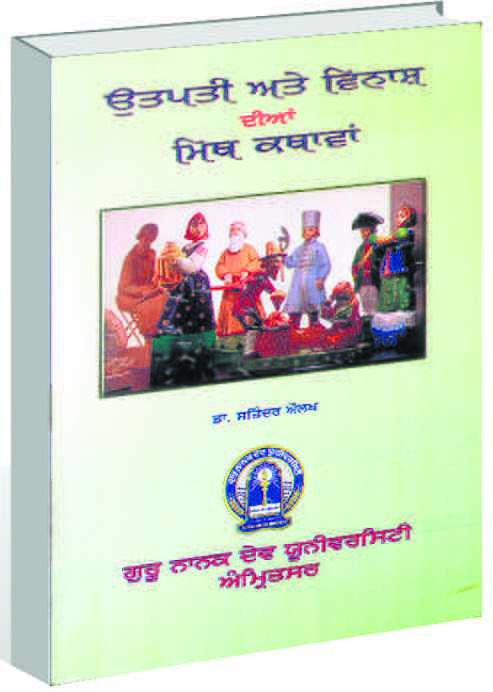
Utpati Ate Vinash Dian Myth Kathawan (The Mythic Tales of Creation and Destruction)
Jaspal Singh
MYTHOLOGY is the product of a fertile imagination of people. It involves a huge meditative effort and linguistic acumen to articulate it. Folklorists and culture scientists then try to decode various myths in order to understand the logic behind these. In fact, myths provide a peek into the working of the sub-conscious mind of a community. Every ancient civilisation has a rich corpus of mythological thought but the Greeks and the Indian have been most prolific in this field. The myths are not ossified structures. They are rather ever growing narratives that sometimes startle even their creators.
Satinder Aulakh, a retired professor from Guru Nanak Dev University, has been working in the field of folk tales and Indian mythological constructs for a long time. She has earlier done a monograph in English on the legend of Mirza Sahiban, The Fast Horse and the Ferocious River. The present book Utpati Ate Vinash Dian Myth Kathawan (The Mythic Tales of Creation and Destruction) is an analytical encyclopaedia of Hindu myths related to creation, sustenance and destruction of the universe (srishti). The myths pertaining to Brahma, Vishnu, Shiv, Kali/Durga, Vasudev/ Krishan, sur, asur and the churning of the oceans, Ganesh and Hanuman have been presented along with their narrative logic and scientific analysis. Satinder does not dismiss the myths, rather she tries to understand and analyse these. She is a trained anthropological linguist. Her study is objective though a little considerate towards the great minds. After all, they had created and preserved these myths as a window to the collective unconscious of the ancients that even today sway the Indian mind.
Most of the Hindu mythology has been drawn from the old texts like the Vedas, the Ramayana and the Mahabharta and the 18 original Puranas. Satinder holds that some of the scholars like Mircea Eliade consider myths as a collective dream of a people. The weird mythological formulations present the unconscious drives and desires through what Freud calls the processes of condensation and displacement. The supernatural figures that appear in the mythological discourse have been invested with human traits both virtuous and vicious ones. So the anthropocentrism involved is obvious.
There are many conflicts and contradictions among different gods, demi-gods and demons. Even in the established sects like Shaiv Mat and Vaishnav Mat, there have been bitter contradictions which were later reconciled. The author has gone through a lot of original classical literature, including Vedas, Upanishadas, epics and Puranas as well as scholarly expositions of Vasudeva Agrawala, S.P. Vasu, N.N. Bhattacharya, K.C. Aryan, Shakti M. Gupta, Mircea Eliade, Max Muller, D.D. Kosambi, Romila Thapar, Debiprasad Chattopadhyaya and so on. In addition to this, the insights gleaned from modern anthropological thinkers and psychologists like Emile Durkhiem, James Frazer, Edmund Leach, Claude Levi–Strauss, Sigmund Freud, C.G. Jung etc. have also been utilised.
She concludes that there is a lot of intermingling of Aryan and non-Aryan myths but there is an ultimate reconciliation. As dynamic structures, myths evolve in contemporary spectacles embracing present day situations, contradictions and problems at socio-economic and political levels. Punjabi readers interested in understanding the basics of Indian mythology cannot ignore this study.



























